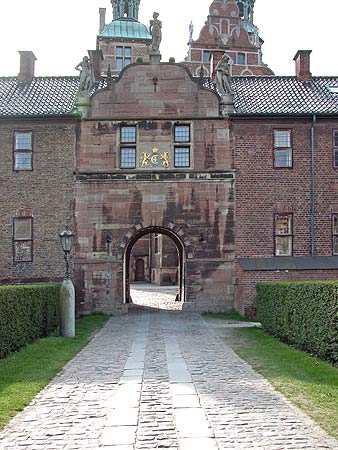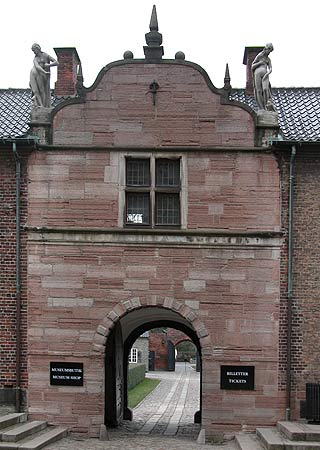INIGO JONES & CHRISTIAN IV
ARCHAEOLOGICAL ENCOUNTERS IN ARCHITECTURE
Acta Archaeologica Supplementa V = Acta Archaeologica 75:1, 2004
(København / Blackwell Munksgaard)
SUMMARY
Basta quell che contenta
[Sufficient what satisfies]
Inigo Jones
The elegant Gate Tower of Rosenborg Castle, Copenhagen of before 1610 (1608?) is a strangely overlooked piece of early architecture by King Christian IV (Fig. 1). It is even more remarkable by being the only still standing element of the first Rosenborg Castle (1606+), which merely has survived as part of the basement and walls of the charming and much admired later castle, in itself almost a stage set as viewed trough and above the gate tower. Architecturally, the gate tower sems almost "English" in simplicity and elegance, and is a surprisingly Vitruvian structure, in fact to be inscribed in Leonardo da Vinci's famous " Vitruvian Man", statues and all (Fig. 2). Even early Bronze Age Stonehenge was reconstructed by Inigo Jones on a Vitruvian model of circles and equilateral triangles.

Fig. 1. The Gate Tower of Rosenborg Castle.

Fig. 2. Vitruvian structure of Rosenborg Gate Tower
By contrast to the gate tower, the first Rosenborg was a rather ordinary piece of architecture, at least to the plan it was built, and so is the Blue House, the king's banqueting hall in the same "Pleasure Garden" (1608+), although not without design, nor charm). The Blue House still exists but is heavily rebuilt (Fig. 3); it is here reconstructed for the first time.

Fig. 3. The Blue House in it's present Neo-Classicist outlook.
Christian IV's architects of the Steenwinckel family - working in a moderate Danish edition of the Flemish or Dutch Renaissance Mannenrist style, in brick and sandstone - cannot be held responsible for the gate tower: the father Hans was long dead and the sons, including Hans the Younger, not in Christian IV's service until later. Their architectural idioms were also other, dominated by "Renaissance" squares. At any rate, the gate tower calls upon a particular agent. This person is likely Inigo Jones, the famous English painter, stage designer and architect, rared in Italy on Palladio and the Classical heritage of the Italian Renaissance. No other architect of standing seems to have operated in Denmark at the time, and Jones was certainly connected with the linked Danish and English courts, Christian's favoured Sister Anne being Queen of England (and Scotland ).
King Christian IV of Denmark entertained very many talented foreign artists - musicians, actors, painters, etc. - at his court, German, Dutch and English. The collaborator of Inigo Jones, John Webb, states that Christian IV sent for Jones out of Italy and first made him realize his own potential, possibly a reference to the employment with King Christian's sister.
Certainly, Jones visited the Danish court in 1603 - at least - and was attached to Queen Anne and the English court as state designer and architect since 1604, being responsible for very many so-called masques, or court entertainments, and, for example, the famous Queen's House in Greenwich (1616+). The latter is possibly inspired by King Christian's Sparepenge Palace (1597 ?/ 1599+) at Frederiksborg Castle north of Copenhagen . In 1610 Inigo Jones became the Surveyor to Prince Henry, the nephew of Christian IV. Christian IV himself visited England in 1606 (attended by Inigo Jones) and 1614. The king's brother, Ulrik , also travelled to England several times.
Inigo Jones being the designer of the Rosenborg Gate Tower would at the same time confirm a core of his rumoured role in Rosenborg Castle . Other rumous give him credits for Fredriksborg Castle (1602+) and even Børsen/The Bourse (1619+), which is clearly wrong. Nevertheless, the King's Privy Passage at Frederiksborg (built 1612+) has a certain "English" character and also applies to " Vitruvian " measures. It may in fact have been based on a drawing with measurements by Inigo Jones, like his preserved drawings of stage sets.
The Børsen connection is probably fed by Jones' drawing of the New Exchange (1608+) in London, which carries a certain similarity to the Copenhagen one, and the false idea that Jones was the architect of the New Exchange. Børsen is here analysed in depth for the first time as to its structural properties. Novel analyses of the same kind are also supplied for King Christian IV's Burial Chapel at Roskilde Cathedral (1613+), Trinity Church at Christianstad and the Mint Gate (1614+) at Frederiksborg Castle, all of these have a different architectural structure ("Renaissance" squares) from the King's Privy Passage and the Rosenborg Castle Gate (" Vitruvian " equilateral triangles etc. of the latter).
Finally, a portrait of King Christian IV, made in England during the visit in 1606, may in fact be by Inigo Jones (Fig. 4). It shows the king of Denmark posing like an English prince, almost like an actor would do. The large amount of drawings of stage sets and princely performers in their dresses by Jones gives evidence for the latter idea: perhaps a chimera, but nevertheless dressed in reality.

Fig. 4. Christian IV (1577-1648).
Quite possibly, the Rosenborg Gate is thus by Inigo Jones, the great modern architect of Britain (Fig. 5). If so, it is not only a novel piece of architecture by his pen - and the mundane work of others - but also his earliest. In fact, Inigo Jones' earliest architectural drawing, a stage set of 1608, "House of Fame", depicts a gate tower on the Rosenborg Gate model.

Fig. 5. The back side of Rosenborg Gate Tower.
|